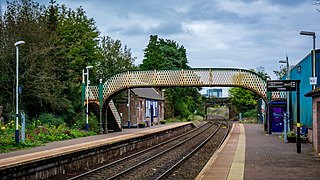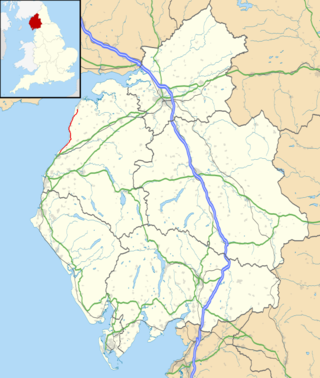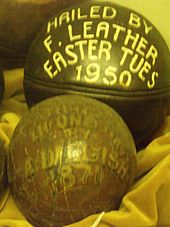
Cumbria is a ceremonial county in North West England. It borders the Scottish council areas of Dumfries and Galloway and Scottish Borders to the north, Northumberland and County Durham to the east, North Yorkshire to the south-east, Lancashire to the south, and the Irish Sea to the west. Its largest settlement is the city of Carlisle.

Workington is a coastal town and civil parish at the mouth of the River Derwent on the west coast in Cumberland, Cumbria, England. At the 2011 census it had a population of 25,207.

Allerdale was a non-metropolitan district of Cumbria, England, with borough status. Its council was based in Workington and the borough has a population of 93,492 according to the 2001 census, increasing to 96,422 at the 2011 Census.

Maryport is a town and civil parish in Cumbria, England.

The Ba' Game is a version of medieval football played in Scotland, primarily in Orkney and the Scottish Borders, around Christmas and New Year.

The Cumbrian Coast line is a rail route in North West England, running from Carlisle to Barrow-in-Furness via Workington and Whitehaven. The line forms part of Network Rail route NW 4033, which continues via Ulverston and Grange-over-Sands to Carnforth, where it connects with the West Coast Main Line.

Workington railway station is a railway station serving the coastal town of Workington in Cumbria, England. It is on the Cumbrian Coast Line, which runs between Carlisle and Barrow-in-Furness. It is owned by Network Rail and managed by Northern Trains.

Flimby railway station serves the coastal village of Flimby in Cumbria, England. It is on the Cumbrian Coast Line, which runs between Carlisle and Barrow-in-Furness. It is owned by Network Rail and managed by Northern Trains.

Maryport railway station is a railway station serving the coastal town of Maryport in Cumbria, England. It is on the Cumbrian Coast Line, which runs between Carlisle and Barrow-in-Furness. It is owned by Network Rail and managed by Northern Trains. It is unstaffed and passengers must buy their ticket on the train or at an automatic ticket machine outside the platform. Step-free access to the platform is available; train running information is provided by digital information screens and timetable posters.

Wigton railway station is a railway station serving the market town of Wigton in Cumbria, England. It is on the Cumbrian Coast Line, which runs between Carlisle and Barrow-in-Furness. It is owned by Network Rail and managed by Northern Trains.

Dalston railway station serves the village of Dalston near Carlisle in Cumbria, England. It is on the Cumbrian Coast Line, which runs between Carlisle and Barrow-in-Furness. It is owned by Network Rail and managed by Northern Trains.
CN Group Limited was formerly an independent local media business based in Carlisle, Cumbria, England, operating in print and radio. It is now owned by Newsquest and their newspapers are printed in Glasgow.

Edward "Eppie" Gibson, was an English professional rugby league footballer who played in the 1940s, 1950s and 1960s. He played at representative level for England and Cumberland, and at club level for Workington Town, as a centre, or stand-off, and was player-coach for Whitehaven.

The B5300 is a B road which runs for approximately twelve miles between the towns of Silloth and Maryport in the Allerdale borough of Cumbria, United Kingdom. From north to south, it passes through the villages of Blitterlees, Beckfoot, Mawbray, Dubmill, and Allonby. It runs through the Solway Coast Area of Outstanding Natural Beauty, passes close to the Salta Moss Site of Special Scientific Interest, Milefortlet 21, a Roman archaeological site, the salt pans, a remnant of the Solway plain's medieval saltmaking industry, and the village of Crosscanonby. It is an important route for carrying goods to and from Silloth docks and Maryport harbour. It is also the major road connecting smaller coastal settlements with Maryport and Silloth, from where other roads lead to Workington, Whitehaven, Wigton, and Carlisle. A short section of the road between Dubmill and Mawbray was closed in February 2019 due to coastal erosion, and reopened in June 2019.

Workington North railway station was a temporary railway station in Cumbria, United Kingdom, constructed following floods which cut all road access to Workington town centre from north of the River Derwent. The station was located 1 mile (1.6 km) north of Workington station on the Cumbrian Coast Line.
Callum Phillips is a Scotland international rugby league footballer who plays as a hooker or scrum-half for Whitehaven in Betfred League 1.

Dunmail Park is a shopping centre located in Siddick, near Workington, in Cumbria, United Kingdom. It is located one-and-a-half miles north of the centre of Workington on the A596, and four-and-a-half miles south of the town of Maryport. It is named after Dunmail, a legendary king of Cumberland.

Papcastle railway station was on the single track Derwent Branch of the Maryport and Carlisle Railway (M&CR) in the then county of Cumberland, now Cumbria, England.
Dovenby Lodge railway station was on the single track Derwent Branch of the Maryport and Carlisle Railway (M&CR) in the then county of Cumberland, now Cumbria, England.
Dearham railway station was on the single track Derwent Branch of the Maryport and Carlisle Railway (M&CR) in the then county of Cumberland, now Cumbria, England.


















